The story of our expedition to observe nesting sea turtles
On a beautiful July evening we accompanied Octavio (who was working at the turtle center at the time) in a small expedition to observe the nesting of sea turtles. At that time of the year (May to September) hundreds of them come to lay their eggs on the Cayo Largo beaches.
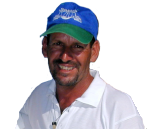 We leave the hotel around 10pm with Octavio to join Mike and Marguerite, two Ontarian tourists who will accompany us. Under a clear sky filled with thousands of stars, we go to the beach in front of the late hotel Villa Capricho. We carefully follow Octavio's instructions who first explains how to detect the presence of a turtle emerging from the sea or digging its nest.
We leave the hotel around 10pm with Octavio to join Mike and Marguerite, two Ontarian tourists who will accompany us. Under a clear sky filled with thousands of stars, we go to the beach in front of the late hotel Villa Capricho. We carefully follow Octavio's instructions who first explains how to detect the presence of a turtle emerging from the sea or digging its nest.
First essential instruction = No flashlights! Artificial light scares the turtles that could turn back and even lay their eggs at sea! Our eyes get used quickly to darkness. We begin to detect the tracks left in the sand by these giants, whose trace contrasts with the white sand (they look like tractor tire tracks!). And now we start to detect the huge oval shapes! Over a distance of less than half a kilometer, we observed 7 turtles!
Some of them were crawling on the beach in search of a nesting spot, dragging their ±200Kg by the sheer force of their front legs. Others were busy digging their nest, while some were getting back to the sea, and finally "the highlight of the evening" ... one was about to lay!
When a turtle emerges from the sea, she needs a clear and safe path; we must remain at a distance and stand still while waiting quietly for her to pass. When she is at the stage of digging her nest or laying eggs, we could then squat and approach her from behind slowly and silently, staying behind her front flippers and away from her head.
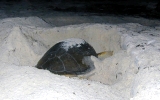 Despite the darkness, Octavio always knew exactly what each turtle was doing! We learned that we should not only try to see, but also to listen well. The turtle first digs a large cavity of a thickness corresponding to about one to one and a half times its height, sweeping the sand from her flippers and rotating her body; this first phase lasts about twenty minutes. She throws sand far away with her front flipper; the noise produced is very characteristic. We approached a little to listen and see better, a shower of sand fell on us! :-)
Despite the darkness, Octavio always knew exactly what each turtle was doing! We learned that we should not only try to see, but also to listen well. The turtle first digs a large cavity of a thickness corresponding to about one to one and a half times its height, sweeping the sand from her flippers and rotating her body; this first phase lasts about twenty minutes. She throws sand far away with her front flipper; the noise produced is very characteristic. We approached a little to listen and see better, a shower of sand fell on us! :-)
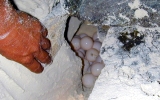 Using her cupped rear flippers as shovels, she then digs an egg cavity of a depth of about 70 cm; this step produces a more felted noise. When the turtle has finished digging her egg chamber, she immediately begins to lay eggs; 100-120 on average. Octavio explains to us that during the laying she is highly focused and our presence is less likely to disturb her. But she must not feel unsafe because she could abort the process; we shall remain discreet. Octavio goes scouting a little further and then rushes back to tell us that a big green turtle is currently laying eggs!
Using her cupped rear flippers as shovels, she then digs an egg cavity of a depth of about 70 cm; this step produces a more felted noise. When the turtle has finished digging her egg chamber, she immediately begins to lay eggs; 100-120 on average. Octavio explains to us that during the laying she is highly focused and our presence is less likely to disturb her. But she must not feel unsafe because she could abort the process; we shall remain discreet. Octavio goes scouting a little further and then rushes back to tell us that a big green turtle is currently laying eggs!
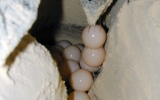 We get closer creeping slowly behind her... she's huge, over 100 kg according to Octavio. He digs the sand behind here to expose the egg chamber, and ... behold before us an unforgettable sight! All those cute round eggs looking like ping pong balls! They are slightly coated with a slippery mucus and fall 2-3 at a time to the rhythm of contractions. They are soft so they do not break as they fall into the chamber. The egg cavity fills up quickly! ... This is AMAZING!
We get closer creeping slowly behind her... she's huge, over 100 kg according to Octavio. He digs the sand behind here to expose the egg chamber, and ... behold before us an unforgettable sight! All those cute round eggs looking like ping pong balls! They are slightly coated with a slippery mucus and fall 2-3 at a time to the rhythm of contractions. They are soft so they do not break as they fall into the chamber. The egg cavity fills up quickly! ... This is AMAZING!
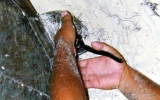 The turtle then buries its eggs. Octavio then fixes a tag to her right front flipper before she goes back to the sea. Tagging helps monitor the return of turtles in subsequent years (a female returns to nest every 3 to 6 years, on the same beach where she was born). She then moves about 2 meters, while throwing sand in all directions with her front flippers to disguise the nesting area.
The turtle then buries its eggs. Octavio then fixes a tag to her right front flipper before she goes back to the sea. Tagging helps monitor the return of turtles in subsequent years (a female returns to nest every 3 to 6 years, on the same beach where she was born). She then moves about 2 meters, while throwing sand in all directions with her front flippers to disguise the nesting area.
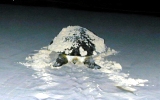 She begins moving towards the water, she seems exhausted, and for good reason! We follow her throughout her slow crawl back to the sea until she disappears into the waves. Once she has left her nest, she never returns to tend it. Each female can nest on average 2-3 times per season. Adult green turtles can swim over 1000 km between their nesting area and the one where they feed.
She begins moving towards the water, she seems exhausted, and for good reason! We follow her throughout her slow crawl back to the sea until she disappears into the waves. Once she has left her nest, she never returns to tend it. Each female can nest on average 2-3 times per season. Adult green turtles can swim over 1000 km between their nesting area and the one where they feed.
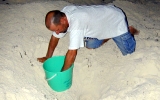 We then return to the nest to collect the eggs. Octavio explains that this section of beach is a bit too narrow and unstable; hence the high risk for the nest to be flooded by the wave before the end of the incubation period. We then return to the nest to collect the eggs. Octavio explains that this section of beach is a bit narrow and unstable; it is highly probable that the nest will be flooded by the wave before the end of the incubation period. The nest contains 117 eggs and only one has broken. Octavio picks them up carefully; he will bring them back to the Turtle Center where they will be re-buried for incubation which will last about 60 days (according to the temperature). It's 1:30 am, we are getting back to our hotel carrying with us 116 little treasures!
We then return to the nest to collect the eggs. Octavio explains that this section of beach is a bit too narrow and unstable; hence the high risk for the nest to be flooded by the wave before the end of the incubation period. We then return to the nest to collect the eggs. Octavio explains that this section of beach is a bit narrow and unstable; it is highly probable that the nest will be flooded by the wave before the end of the incubation period. The nest contains 117 eggs and only one has broken. Octavio picks them up carefully; he will bring them back to the Turtle Center where they will be re-buried for incubation which will last about 60 days (according to the temperature). It's 1:30 am, we are getting back to our hotel carrying with us 116 little treasures!
We fall asleep thinking that in a couple of months other tourists may have the chance to release these cute little ones to the sea, and hoping that as many as possible will reach maturity in order to return to Cayo Largo one day!
This experience is engraved in our memory forever ...
¡ MUCHAS GRACIAS OCTAVIO !
 For more information on the conservation work done in Cayo Largo, please visit our page dedicated to the Centro de Rescate de Tortugas Marinas
For more information on the conservation work done in Cayo Largo, please visit our page dedicated to the Centro de Rescate de Tortugas Marinas
Lily & Normand
© cayolargo.net
© destilino.com



